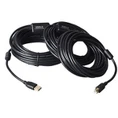Almost everyone knows HDMI in the HD time, because is the most mainstream HD video transmission interface, and the latest 2.1A specification can even support 8K Ultra HD video specifications. The main material of the traditional HDMI cable is mostly copper, but the copper core HDMI cable has a disadvantage, that is, the signal will be affected when transmitting over long distances. As a result, new material fiber has come out.
So what is the difference between with HDMI Optiacal cable and a normal HDMI cable? STC will explain to you today the difference between the two.
1) The core is different
The optical fiber HDMI cable uses a fiber core, and the material generally has two kinds of glass fiber and plastic fiber. Compared to the two materials, the glass fiber loss is smaller, but the cost of the plastic fiber is lower. In order to ensure performance, it is generally recommended to use plastic optical fiber at a distance of less than 50 meters and glass fiber for use at a distance of 50 meters or more. The ordinary HDMI cable uses copper core wire, of course, there are upgraded versions such as silver-plated copper and sterling silver wire. The different materials determine the huge difference between the fiber HDMI cable and the conventional HDMI cable in their respective fields. For example, the fiber optic cable will be very thin, light, and soft; while the conventional copper core wire will be thick, heavy, and hard.

(2) The chip is different
The optical fiber HDMI cable adopts the photoelectric conversion chip engine, which needs to realize the signal transmission through two photoelectric conversions: once the electrical signal is converted into an optical signal, then the optical signal is transmitted in the optical fiber line, and then the optical signal is converted into an electrical signal to realize The signal is effectively transmitted from the SOURCE terminal to the DISPLAY terminal. The conventional HDMI cable uses electrical signal transmission and does not require two photoelectric conversions.

(3) Different transmission effectiveness
As mentioned above, the principle of the chip scheme adopted by the optical fiber HDMI cable and the conventional HDMI cable is different, and thus there is a difference in transmission performance. Generally speaking, since the photoelectric needs to be converted twice, the difference in transmission time between the short-line optical HDMI cable and the conventional HDMI cable within 10 meters is not large, so it is difficult to have absolute performance in the short-term performance. The fiber optic HDMI cable can support lossless transmission over 150 meters without the need for a signal amplifier. At the same time, due to the use of optical fiber as the transmission carrier, the high fidelity effect of the signal is better and better, and it is not affected by the electromagnetic radiation of the external environment, which is very suitable for games and demanding industries.
(4) Large price difference
At present, due to the optical fiber HDMI cable as a new thing, the industry scale and user group are relatively small. Therefore, on the whole, the size of the optical fiber HDMI cable is small, so the price is still at a high level, and it is generally several times more expensive than the copper core HDMI cable. Therefore, the current conventional copper core HDMI cable is still irreplaceable in cost performance.
There are also reasons for the high price of fiber-optic HDMI cable, because it has too many advantages. Let me give you a few advantages of the fiber optic HDMI cable:
Light weight and light weight. Because the material uses light weight fiber, the fiber HDMI cable is smaller, lighter, softer, more suitable for large-area embedding, and has superior resistance to bending and impact. Therefore, it is more suitable for installation in small spaces.

2. The transmission distance is long. Adopting optical fiber transmission medium, the signal transmission attenuation over long distance can be neglected, and the longest transmission distance can reach more than 300m. Due to the use of optical signal transmission, the anti-interference ability of the optical fiber HDMI line transmission process is strong and the transmission is stable. This feature is especially important for home theater, because even in the living room theater, the pre-embedded HDMI cable is at least 10 meters.

3. Lossless transmission. Audio and video transmission truly realizes lossless transmission, and video information and audio information are completely immune to external electromagnetic interference, ensuring high fidelity of the transmitted signal. Especially for the audio information with extremely high transmission material requirements, the ultra-low noise floor ensures the sound is pure and pure.

4. A wider range of applications. The optical fiber HDMI cable has been compliant with the HDMI2.0 standard, and can directly transmit 4K 60FPS ultra-clear signals without being affected by distance. It can be applied to various occasions where high-definition video display devices and large-area wiring connections are required, and the application fields are very wide. For example, home theater systems, remote information distribution systems, broadcast television control systems, public security HD surveillance systems, high-definition video conferencing office systems, multimedia systems, large medical imaging systems, industrial automation systems, and more.






